- Click 'License Management' > 'License Management' > 'Licenses'
The 'Licenses' interface lets you add and renew licenses, change license allocation, distribute seats among customers, create reports, and more.
Open the license management interface
- Login to ITarian
- Click 'Applications' > 'Endpoint Manager'
- Click 'License Management' > 'License Management'
- Select the 'Bill Forecast' tab

The bill forecast interface summarizes the license usage on your account.
- Total seats - The number of licensed seats you have available per product.
- Enrolled Endpoint Counts – The number of devices you have enrolled in each product category. Here are the conditions under which a device is classed as ‘enrolled’ for each category:
- Endpoint Manager - The device has the communication client (CCC) installed, but not the security client (CCS) or Endpoint Detection and Response (EDR) client.
- Advanced Endpoint Protection - Device that CCS installed.
- Endpoint Detection and Response - Device which EDR client installed.
If a device has both the CCS and EDR clients installed, it will be added to the counts for both products.
- Overuse - The number of unlicensed endpoints. You will need to purchase licenses for unlicensed endpoints.
You can view the pricing model description in the 'Billforecast' Page
- Click the 'Question Mark' symbol -> Select 'See Pricing'
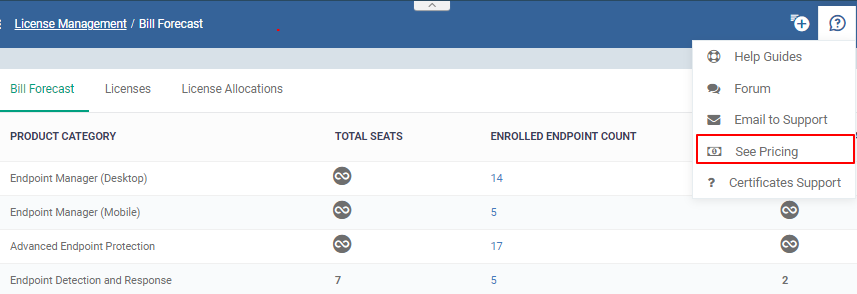
This will navigate to the https://www.itarian.com/pricing.php page. Here you can find the frequently asked questions with answers and also a pricing model description.
The 'Licenses' tab shows all available licenses and their seat allocations.
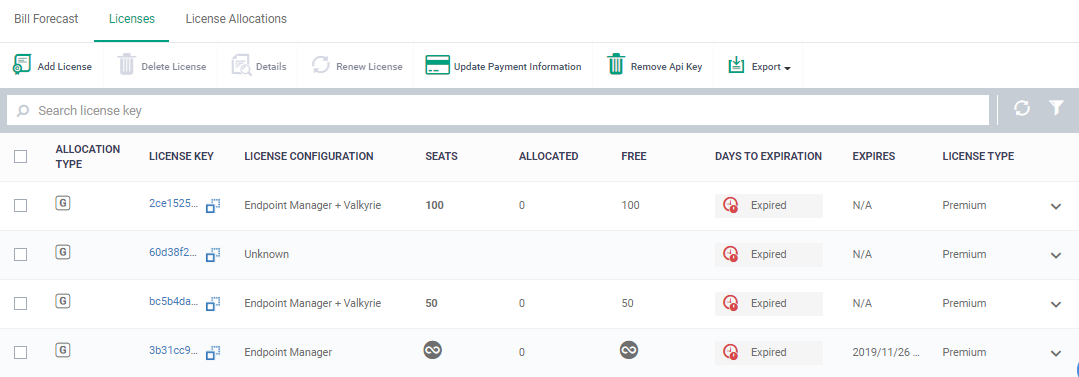
- Allocation Type - States whether you can use the license for multiple customers or a single customer.
- Global (G) - You can use the license for multiple customers
- Allocated (A) - You can use the license on a single customer.
You can change the allocation type of a license as follows:
- License Key - Unique identifier for the license.
- License Configuration - The security features which are included on the license.
- Seats - Number of devices covered by the license.
- The infinity symbol icon indicates unlimited seats.
- These licenses support unlimited devices but are limited to a one month term.
- Allocated - The number of seats that you have already assigned to devices.
- Seats can be assigned to a single customer or multiple customers.
- Free - Number of seats remaining on the license.
- Days to Expiration - Number of days left on the license.
- Expires - License period end date and time
- License Type - Indicates whether the subscription is free, premium or managed.
Add a License
You can purchase new licenses from Comodo Account Manager (CAM) at https://accounts.comodo.com.
- Log in at https://accounts.comodo.com with your Comodo username and password
- Select 'Endpoint Manager' and complete the purchase process.
- Your license key will be sent to your registered email address.
Upgrade a license
Alternatively, click 'License Options' at the top of the Endpoint Manager interface.
- This opens a comparison of available license types:
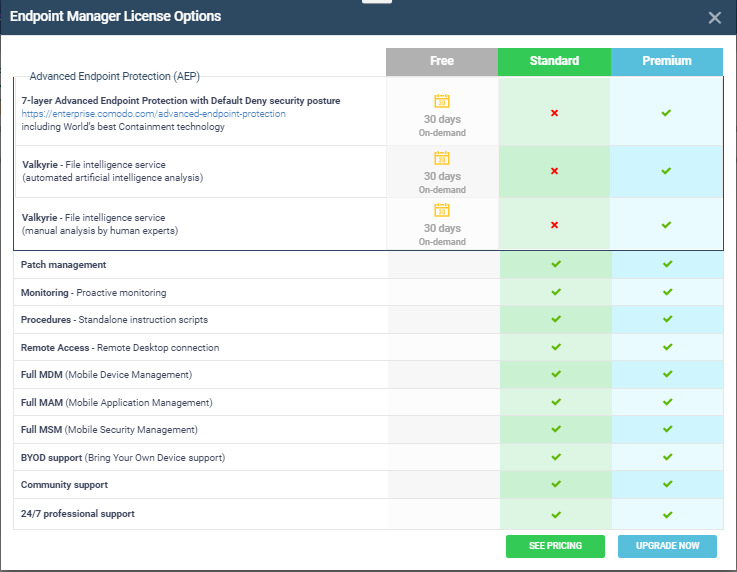
- Click 'Upgrade Now' under the license type you want.
- You will be taken to the order forms to complete the purchase.
Register the license
Once you have obtained a new license, you need to register it in Endpoint Manager.
- Click 'License Management' > 'License Management'
- Open the 'Licenses' tab
- Click 'Add New License' at the top left.
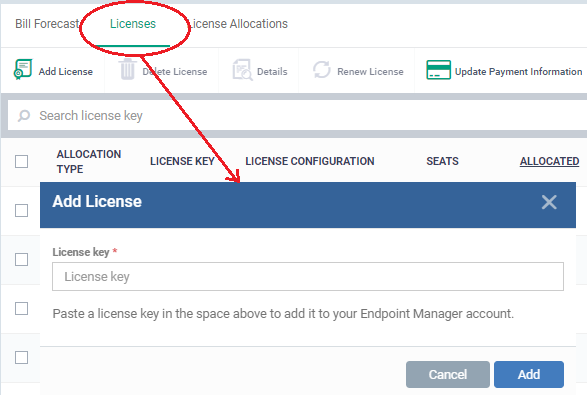
- Enter the license key from your confirmation email.
- Click 'Add'.
Your new license is shown in the 'License Key' column.
View License Details and Change Allocation Type
- Click 'License Management' > 'License Management'
- Open the 'Licenses' tab
- Select the license and click 'Details' at the top.

The license details screen has three tabs:
- License Summary – Details of your subscriptions for Endpoint Manager and other Comodo products. You can change the license allocation type from here too.
- Customers – This shows how your license seats are distributed among your customers. You can change seat allocation from here.
- Report Settings – Configure license usage reports.
License Summary
- Main License Details - Info about your main Endpoint Manager subscriptions.
- Sub-License Details - Info about additional subscriptions included with the main license. These licenses are for other Comodo products such as Valkyrie.
Change License Allocation Type
- Click on a license key to open its details screen
- Click the ‘Edit’ button on the right
- Use the drop-down menu to change the allocation type:
- Global (G) - You can use the license for multiple customers
- Allocated (A) - You can use the license on a single customer
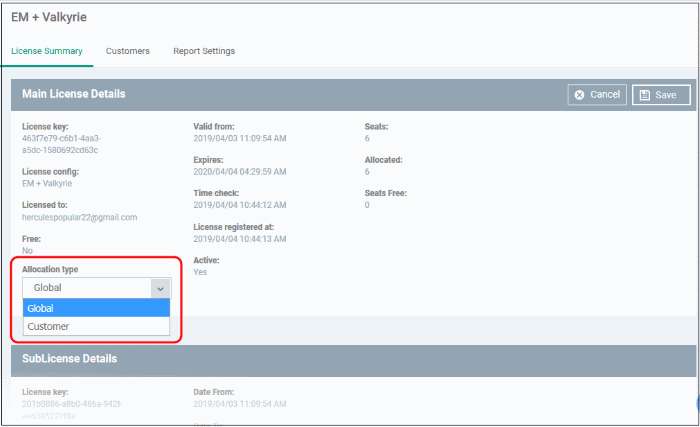
- Click 'Save'.
- You can assign seats to specific customers in the ‘Customers’ tab.
Customers
The customer's area shows how your seats are distributed among your customers. You can reallocate seats, add new licenses to a customer, renew licenses, and more.
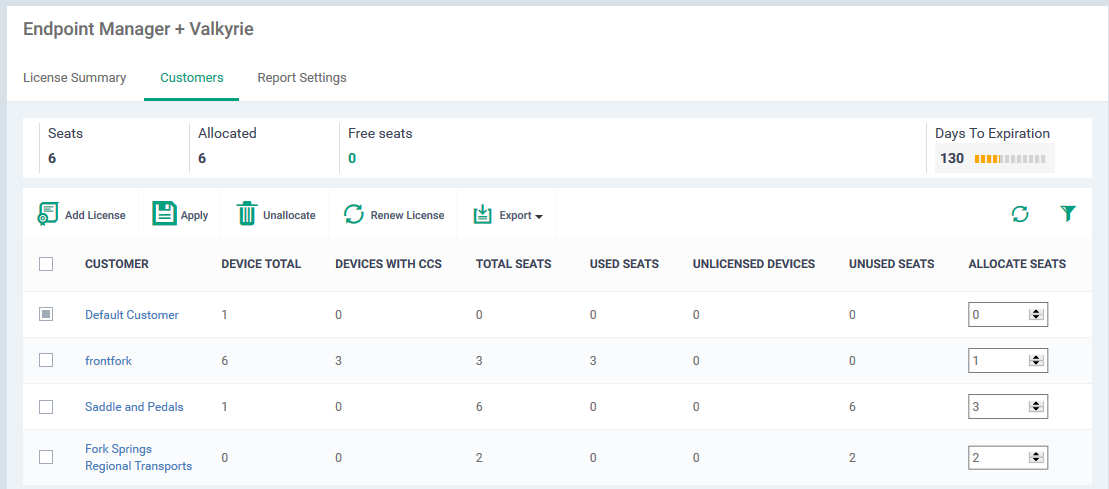
The top row shows the total number of seats covered by the license, seats assigned to customers, and the number of seats remaining.
- Customer - Name of your client. Click the name to view their license usage.
- Device Total - Number of endpoints you have assigned to the customer in Endpoint Manager.
- Device with CCS - Number of endpoints that have Comodo Client Security (CCS) installed
- Total Seats - Number of seats available on all licenses assigned to the customer
- Used Seats - Number of seats currently assigned to the customer’s endpoints
- Unlicensed Devices - Number of endpoints that have Comodo Client Security (CCS) installed, exceeding the total number of seats available to the customer.
- Unlicensed Devices = Device with CCS - Total Seats
- Unused Seats - Number of seats remaining on the license
- Unused seats = Total seats - Used seats
- Allocate Seats - Add or remove seats to/from the customer
The interface allows you to:
Export the seat distribution report for a license
- Click 'License Management' > 'License Management'
- Open the 'Licenses' tab
- Select the license and click 'Details' at the top
- Click the 'Customers' tab
- Click the 'Export' button above the table then choose 'Export to CSV':
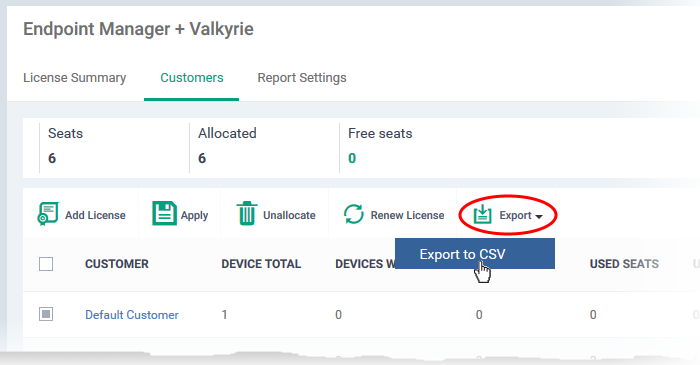
- You can download the report at 'Dashboard' > 'Reports'
Distribute seats to different customers
- Click 'License Management' > 'License Management'
- Open the 'Licenses' tab
- Expand a license row to view your customers
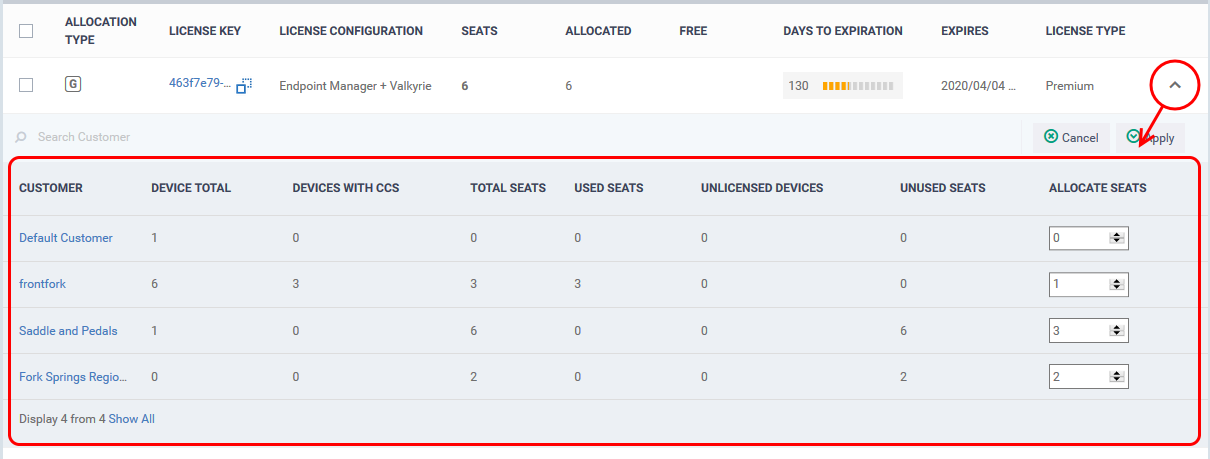
OR
- Select a license then click 'Details’ > Click the 'Customers' tab
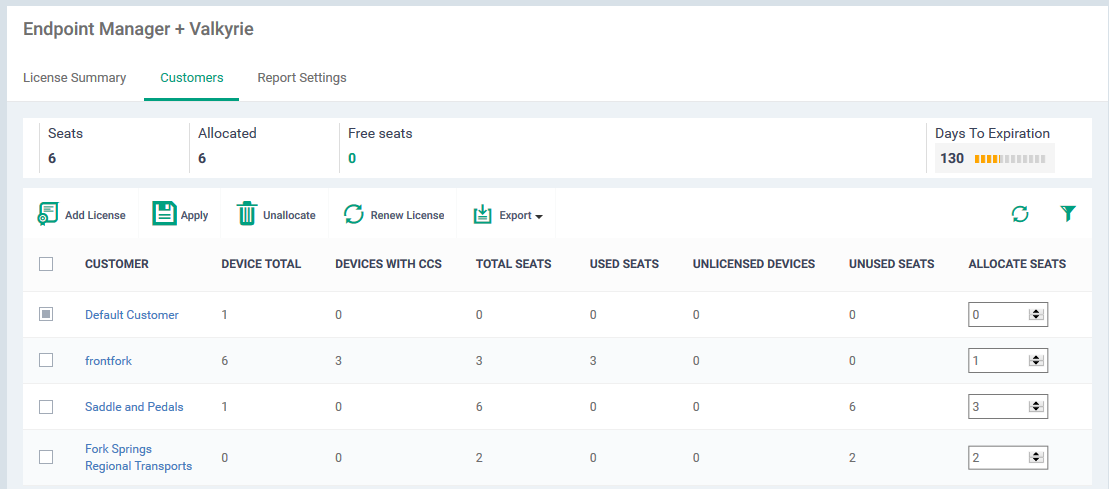
Allocate seats to a customer
- Type a number in the 'Allocate seats' box next to a customer to assign seats to them.
- Click 'Apply'
- Make sure enough free seats are available on the license.
Remove seats from customer
- Select a customer and click 'Unallocate'.
Configure Usage Report Settings
The report contains details on the license period, allocation type, customers covered by the license, total devices used, and so on.
- Click 'License Management' > 'License Management'
- Open the 'Licenses' tab
- Select the license and click 'Details' at the top
- Open the 'Report Settings' tab and click 'Edit' at top-right
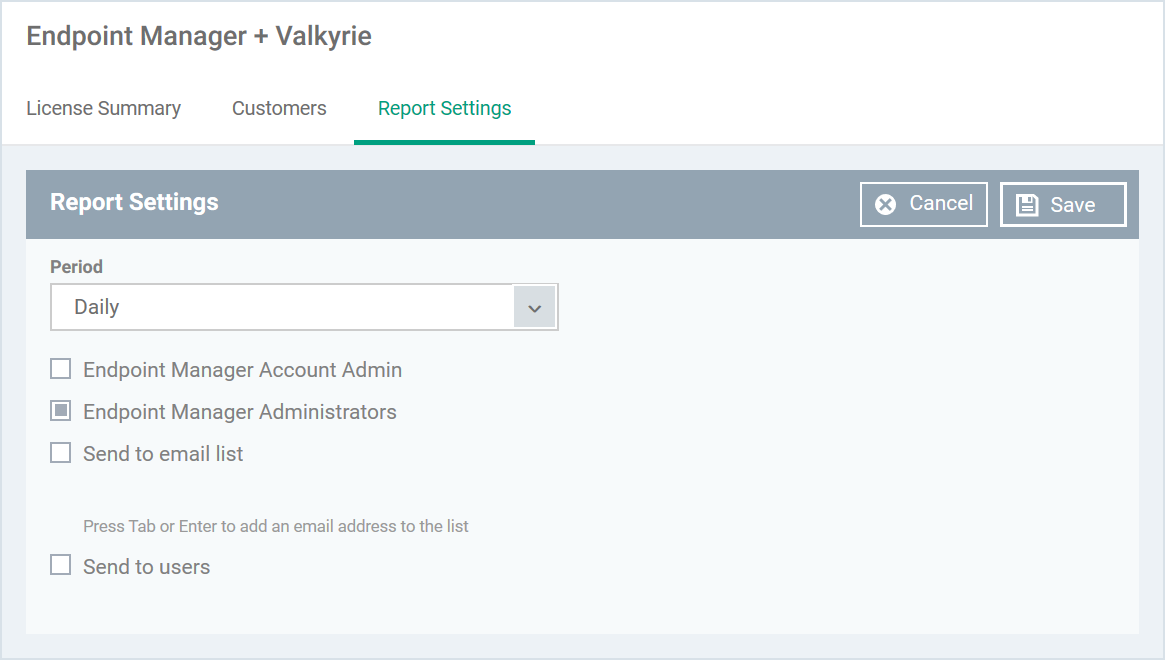
- Period - How frequently the report is generated.
- Endpoint Manager Account Admin - Send the report to the ITarian account administrator
- Endpoint Manager Administrators - Send the report to users with the admin role
- Send to email list - Add the mail addresses of people to whom the report should be sent.
- Enter an email address then press 'Enter'. Repeat the process to add more addresses.
- Send to users - Add enrolled users to whom the report should be sent.
- Enter the first few letters of a username then select from the suggestions.
- Click 'Save'
Renew a License
- Click 'License Management' > 'License Management'
- Open the 'Licenses' tab
- Select the license and click 'Renew License' at the top
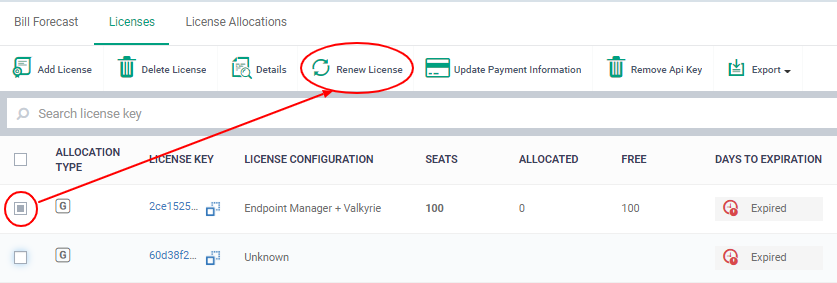
The 'License Options' screen shows a comparison of available license types:

- Click 'Upgrade Now' under the license type you want.
- You will be taken to the order forms to complete the purchase.
Export the list of licenses
- Click 'License Management' > 'License Management'
- Open the 'Licenses' tab
- Click the funnel
 icon to filter which records are included in the report.
icon to filter which records are included in the report.
- Click the 'Export' button above the table then choose 'Export to CSV':
- The CSV file will be available in 'Dashboard' > 'Reports'
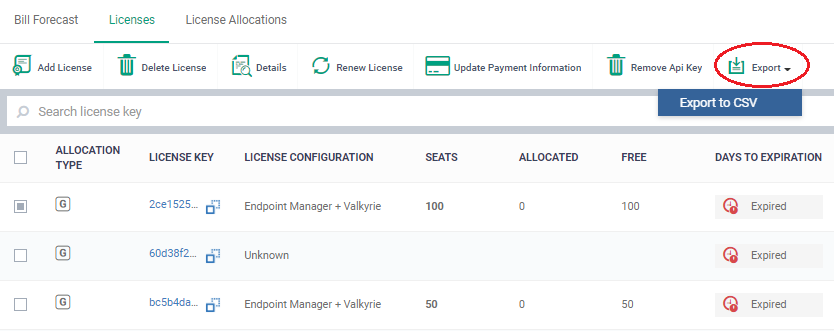
- See this wiki for details on generating and viewing reports from the Endpoint Manager dashboard.
Delete a License
- Click 'License Management' > 'License Management'
- Open the 'Licenses' tab
- Select the license and click 'Delete License' at the top
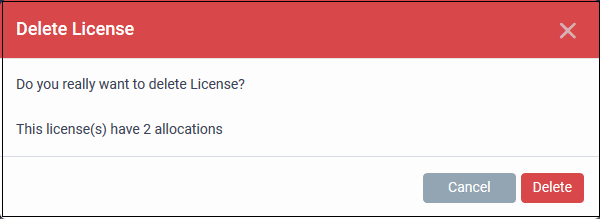
- Click 'Delete' to remove the license from the list.
Note - You can add the license again if required. See register the license above for more help.














 icon to filter which records are included in the report.
icon to filter which records are included in the report.

